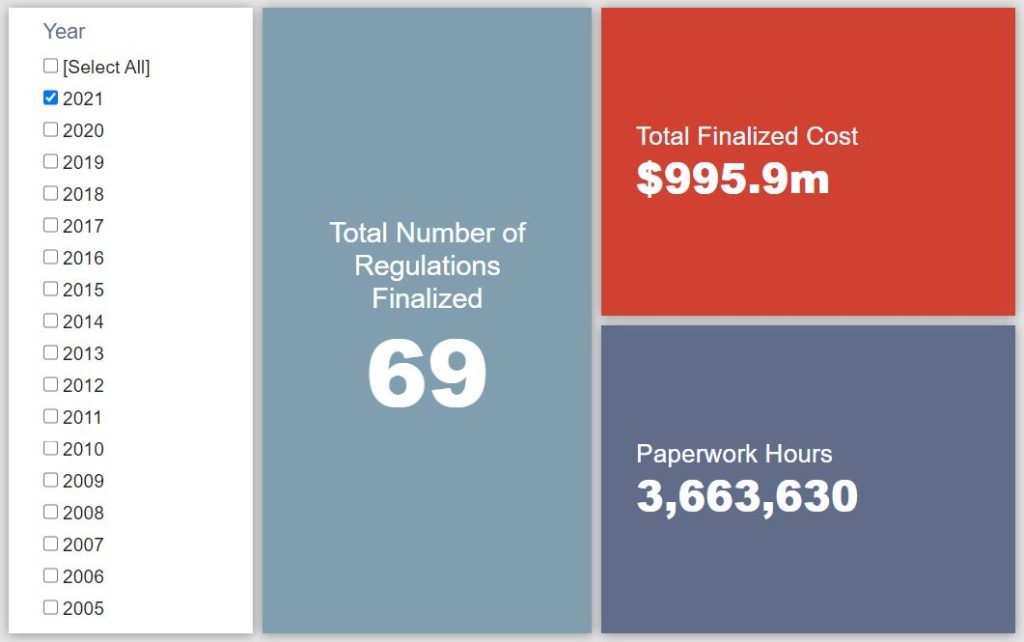Week in Regulation
March 22, 2021
Public Charge Rule’s End Becomes Official
If not for a notice finalizing a court-ordered vacatur of a Trump-era immigration rule, last week would have been quite the dud in terms of regulatory activity. The only other rule of any real note beyond that, however, was a relatively limited Environmental Protection Agency (EPA) rule on water standards in Oregon. Across all rulemakings, agencies published $307.9 million in total net cost savings and cut 757,131 hours of annual paperwork.
REGULATORY TOPLINES
- Proposed Rules: 39
- Final Rules: 45
- 2021 Total Pages: 15,043
- 2021 Final Rule Costs: $995.9 million
- 2021 Proposed Rule Costs: -$8.3 billion
NOTABLE REGULATORY ACTIONS
The most significant rulemaking of the week was the rule implementing a court order on the Trump Administration’s “Public Charge Rule.” This action removes the Trump rule’s text from the Code of Federal Regulations, and thus removes said rule’s estimated burdens. The fuller implications of this rulemaking are the focus of “This Week’s Regulatory Picture” below. The only other rule worth noting here is the EPA rule on “Federal Aluminum Aquatic Life Criteria Applicable to Oregon.” EPA estimates that these standards would impose between $1.2 and $8.1 million in annualized costs ($4.6 million is the midpoint of this range).
TRACKING THE ADMINISTRATIONS
As we have already seen from executive orders and memos, the Biden Administration will surely provide plenty of contrasts with the Trump Administration on the regulatory front. And while there is a general expectation that the new administration will seek to broadly restore Obama-esque regulatory actions, there will also be areas where it charts its own course. Since the American Action Forum’s RegRodeo data extend back to 2005, it is possible to provide weekly updates on how the top-level trends of President Biden’s regulatory record track with those of his two most recent predecessors. The following table provides the cumulative totals of final rules containing some quantified economic impact from each administration through this point in their respective terms.
![]()
Outside of the respective impacts of the rules mentioned above, there was little else moving the needle in the Biden Administration’s to-date regulatory trends. Furthermore, now two months into this term, the most significant finding to draw from broader historical trends across administrations is that: the early weeks of an administration are relatively stable. The table below illustrates this lack of variance.
![]()
This makes sense on an intuitive level. First, each administration freezes activity from the outset. Outside of a handful of outliers, this obviously limits dramatic regulatory action. Second, the natural time-related constraints of the typical rulemaking process – especially for significant rules – limits how quickly a novel rule can become final. An interesting aspect of this exercise in coming months will be to try and ascertain whether: A) there is an inflection point after which regulatory activity starts to take more dramatic swings and B) if that point is consistent across administrations.
THIS WEEK’S REGULATORY PICTURE
This week, the saga of the Public Charge Rule comes to an end.

On March 15, the Department of Homeland Security (DHS) published a Federal Register notice that it was removing the Public Charge Rule from its books. The action stemmed from a federal court ruling in that vacated the rule, effectively killing it.
The controversial rule was published in August 2019. It expanded the criteria under which officials can deny admittance to public charges, or individuals that officials believe will become primarily dependent on the government for subsistence. It was one of many immigration barriers the Trump Administration erected via regulation and came with an estimated total cost of $352 million.
The Public Charge Rule spent its life embroiled in legal uncertainty. Five federal courts issued injunctions in 2019 blocking the rule from taking effect. Those injunctions themselves were stayed early in 2020, which allowed DHS to apply the rule in February of that year. Following the application of the rule, three federal circuit courts reimposed injunctions preventing the rule from being applied. Those injunctions were followed by a federal district court ruling that vacated the rule entirely. After the file of an appeal from the Trump Administration, the Seventh Circuit Court of Appeals stayed the district court’s decision while the appeal was heard.
Before that appeal concluded, the Biden Administration took office. On March 9, the Biden DHS moved to dismiss its appeal as it opposed the Trump rule and did not think it was worth defending. The Seventh Circuit dismissed the appeal, allowing the vacatur to take effect.
TOTAL BURDENS
Since January 1, the federal government has published $7.3 billion in total net cost savings (with $995.9 million in new costs from finalized rules) and 7.3 million hours of net annual paperwork burden reductions (with 3.7 million hours in increases from final rules).












